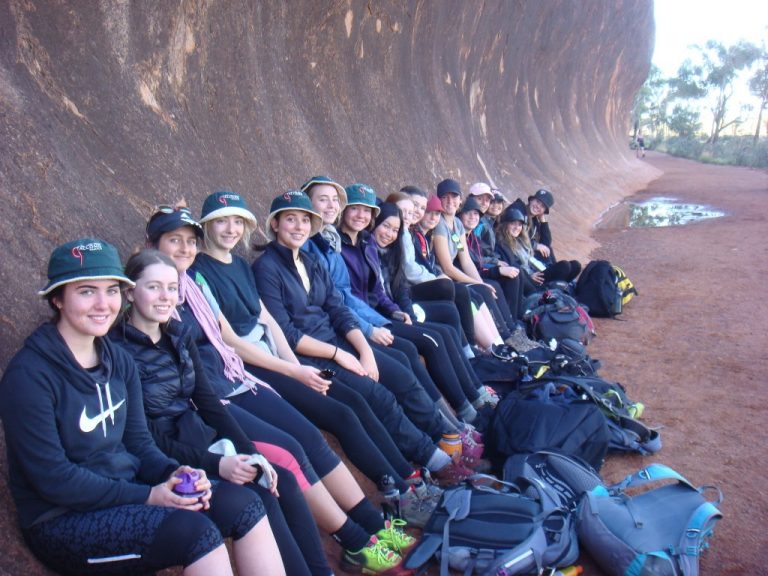I am one of seventeen extremely privileged students from Years 9 and 10 who had the opportunity to experience the Central Australia Immersion this year. I began this journey with excitement as well as nervous anticipation as I, and many others on the journey, found leaving home for nine days, with no technology or contact with our families or friends a little daunting. Not to mention sleeping in swags under the stars and with a forecast of rainfall, we were a long way from our comfort zones. Little did I know this would be one of the most incredible journeys of my life.
We arrived at Ayers Rock Airport surrounded by red earth with the magnificent Uluru in the background. Our first campsite on the Anangu Pitjantjatjara Yankunytjatjara (APY) Lands was the community in Docker River, only eight kilometres from Western Australia. Within this small community we got to know some of the most humble, generous, caring and joyful people I have ever met. We spent time at the school, both the secondary and primary campuses, reading with the children, sharing their learning experiences, helping with maths skills and learning Pitjantjatjara.
We visited Docker River Aged Care and the community encouraged us as we sang the Maku song which celebrates the gift of Maku (witchety grubs). As we began to sing and dance, other residents appeared on the verandahs and were soon clapping and singing with us. This was an amazing experience to share with and listen to people who have lived through so much in their lives.
Docker River, although surrounded by a beautiful landscape, was also confronting and challenging to see a lifestyle so different to our experiences. It allowed us to appreciate the challenges within remote communities as they struggle to access health facilities, education, employment and affordable healthy food. We saw the difficulties in accessing these basic necessities balanced with a strong connection with and need to be part of the land.
The traditional custodian of the Tjukurpa (stories, lore and land) at Cave Hill, Stanley welcomed us onto his homeland. He was a gently spoken Elder from his community who patiently showed and demonstrated ancient tools and how they were used to collect Kooka (meat) and Mai (seeds). Stanley led us through part of the Seven Sisters Songline. It was amazing to hear this ancient story told by Stanley as he guided us through the story and showed the evidence within the landscape itself. Knowing the songline, allows you to know where to find food sources, shelter and water. The songlines are like road maps guiding and leading the way across the desert.
Cave Hill is also home to one of the largest sites of ancient artwork in Australia. This artwork has been dated at more than 20,000 years old and we were able to sit within this cave and see this artwork for ourselves. We climbed to the top of Cave Hill and had a 360 degree view of the most beautiful sunset I have ever seen, and felt the remoteness, beauty and isolation of this sacred place.
During this immersion journey I have made connections with students from both year groups. Some students I didn’t know before the journey and girls in my own year whom I didn’t know well. This is something unexpected that my journey to Central Australia offered to me and I am forever grateful for the friendships I now share.
If I had one thing to say to anyone considering experiencing this immersion, I would say that this is truly a once in a lifetime opportunity and you too should experience it. Not only are you privileged to see and know places that are not accessible to everyone, but you have the most precious gift of all……Time. Time to meet people, Time to create memories, Time to sit with, Time to listen, Time to reflect and Time to get away from our busy daily schedules and learn from and be part of this ancient and extraordinary land.
Anna-Rosa Harman
Year 10



